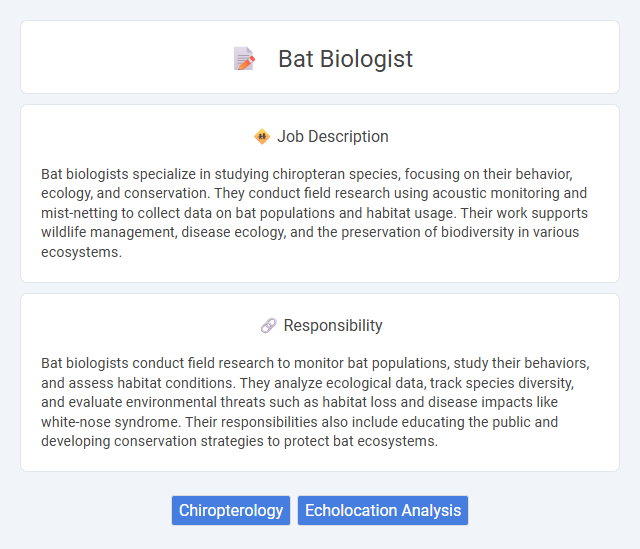
Bat biologists specialize in studying chiropteran species, focusing on their behavior, ecology, and conservation. They conduct field research using acoustic monitoring and mist-netting to collect data on bat populations and habitat usage. Their work supports wildlife management, disease ecology, and the preservation of biodiversity in various ecosystems.
Individuals with a strong curiosity about wildlife and a tolerance for working in dark, sometimes isolated environments may be well-suited for a bat biologist career. Those who are comfortable with fieldwork, including navigating caves and handling delicate creatures, likely have a higher probability of success. Candidates who prefer structured office settings or have sensitivity to close encounters with bats may find this role less compatible with their preferences.
Qualification
A bat biologist typically requires a bachelor's degree in biology, zoology, or environmental science, with many positions preferring a master's or Ph.D. in wildlife biology or ecology. Key qualifications include expertise in chiropterology, proficiency in using mist nets and acoustic monitoring equipment, and strong skills in data analysis and field research techniques. Experience with habitat assessment, species identification, and conservation strategies enhances job prospects in academic, governmental, or environmental consultancy roles.
Responsibility
Bat biologists conduct field research to monitor bat populations, study their behaviors, and assess habitat conditions. They analyze ecological data, track species diversity, and evaluate environmental threats such as habitat loss and disease impacts like white-nose syndrome. Their responsibilities also include educating the public and developing conservation strategies to protect bat ecosystems.
Benefit
A career as a bat biologist may offer meaningful opportunities to contribute to wildlife conservation and ecosystem balance, potentially leading to job satisfaction. There is a probability of engaging in diverse fieldwork that could enhance one's expertise in animal behavior and environmental science. Benefits might also include collaboration with research institutions and participation in important ecological studies that inform conservation policies.
Challenge
A bat biologist likely encounters significant challenges related to nocturnal fieldwork and the difficulty of tracking elusive species. They probably face obstacles in data collection due to bats' rapid flight patterns and their habitats in hard-to-reach locations like caves or dense forests. Managing the conservation of threatened bat populations may also require navigating complex environmental regulations and public misconceptions.
Career Advancement
Bat biologists specializing in chiropterology can advance their careers through roles in academic research, wildlife conservation agencies, or environmental consulting firms. Gaining expertise in bat ecology, disease dynamics, and acoustic monitoring technology enhances opportunities for leadership positions, grant acquisition, and policy advising. Professional growth is often supported by publishing peer-reviewed studies, attending specialized conferences, and collaborating on interdisciplinary projects involving bat population management and habitat restoration.
Key Terms
Chiropterology
A bat biologist specializing in chiropterology studies the behavior, ecology, and physiology of bats to understand their role in ecosystems and aid in conservation efforts. Expertise in habitat analysis, echolocation research, and species identification supports biodiversity preservation and zoonotic disease monitoring. Proficiency in fieldwork techniques and data analysis tools is essential for advancing knowledge in chiropteran biology.
Echolocation Analysis
Bat biologists specializing in echolocation analysis utilize advanced bioacoustic tools to study frequency modulation and call patterns, revealing critical insights into bat navigation and prey detection. They conduct field recordings using ultrasonic detectors and analyze sonar signals through spectrogram software, enhancing species identification accuracy and behavioral understanding. Proficiency in signal processing and ecological data interpretation enables these scientists to contribute to conservation strategies addressing habitat loss and environmental changes.
 kuljobs.com
kuljobs.com